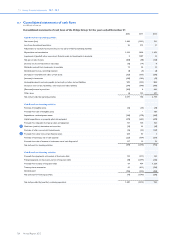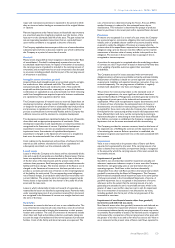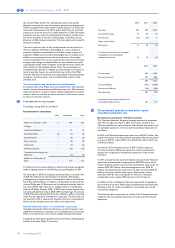Philips 2012 Annual Report Download - page 134
Download and view the complete annual report
Please find page 134 of the 2012 Philips annual report below. You can navigate through the pages in the report by either clicking on the pages listed below, or by using the keyword search tool below to find specific information within the annual report.
12 Group financial statements 12.10 - 12.10
134 Annual Report 2012
be generated by the asset. If the carrying amount of an asset is deemed
not recoverable, an impairment charge is recognized in the amount by
which the carrying amount of the asset exceeds the recoverable
amount. The review for impairment is carried out at the level where
discrete cash flows occur that are independent of other cash flows.
Impairment losses recognized in prior periods are assessed at each
reporting date for any indications that the loss has decreased or no
longer exists. An impairment loss is reversed if and to the extent there
has been a change in the estimates used to determine the recoverable
amount. The loss is reversed only to the extent that the asset’s carrying
amount does not exceed the carrying amount that would have been
determined, net of depreciation or amortization, if no impairment loss
had been recognized. Reversals of impairment are recognized in the
Statement of income.
Impairment of financial assets
A financial asset is considered to be impaired if objective evidence
indicates that one or more events have had a negative effect on the
estimated future cash flows of that asset. In case of available-for-sale
financial assets, a significant or prolonged decline in the fair value of the
financial assets below its cost is considered an indicator that the
financial assets are impaired. If any such evidence exists for available-
for-sale financial assets, the cumulative loss - measured as the difference
between the acquisition cost and the current fair value, less any
impairment loss on that financial asset previously recognized in the
Statement of income - is reclassified from the fair value reserve in equity
to the Statement of income.
If objective evidence indicates that financial assets that are carried at
cost need to be tested for impairment, calculations are based on
information derived from business plans and other information available
for estimating their fair value. Any impairment loss is charged to the
Statement of income.
An impairment loss related to financial assets is reversed if in a
subsequent period, the fair value increases and the increase can be
related objectively to an event occurring after the impairment loss was
recognized. The loss is reversed only to the extent that the asset’s
carrying amount does not exceed the carrying amount that would have
been determined if no impairment loss had been recognized. Reversals
of impairment are recognized in the Statement of income except for
reversals of impairment of available-for-sale equity securities, which are
recognized in other comprehensive income.
Employee benefit accounting
A defined-contribution plan is a post-employment benefit plan under
which an entity pays fixed contributions into a separate entity and will
have no legal or constructive obligation to pay further amounts.
Obligations for contributions to defined-contribution pension plans are
recognized as an employee benefit expense in the Statement of income
in the periods during which services are rendered by employees.
A defined-benefit plan is a post-employment benefit plan other than a
defined-contribution plan. The net pension asset or liability recognized
in the Consolidated balance sheet in respect of defined-benefit
postemployment plans is the fair value of plan assets less the present
value of the projected defined-benefit obligation (DBO) at the balance
sheet date, together with adjustments for projected unrecognized past-
service costs. The projected defined-benefit obligation is calculated
annually by qualified actuaries using the projected unit credit method.
Recognized assets are limited to the present value of any reductions in
future contributions or any future refunds.
To the extent that post-employment benefits vest immediately
following the introduction of a change to a defined-benefit plan, the
resulting past service costs are recognized immediately.
For the Company’s major plans, a full discount rate curve of high-
quality corporate bonds (Towers Watson RATE:Link; 2011:
Bloomberg) is used to determine the defined-benefit obligation,
whereas for the other plans a single-point discount rate is used based
on the plan’s maturity. Plans in countries without a deep corporate
bond market use a discount rate based on the local sovereign curve
and the plan’s maturity.
Pension costs in respect of defined-benefit postemployment plans
primarily represent the increase of the actuarial present value of the
obligation for postemployment benefits based on employee service
during the year and the interest on this obligation in respect of
employee service in previous years, net of the expected return on plan
assets.
Actuarial gains and losses arise mainly from changes in actuarial
assumptions and differences between actuarial assumptions and actual
experience. The Company immediately recognizes all actuarial gains
and losses in other comprehensive income.
The Company recognizes gains and losses on the curtailment or
settlement of a defined-benefit plan when the curtailment or settlement
occurs. The gain or loss on curtailment comprises any resulting change
in the fair value of plan assets, change in the present value of defined-
benefit obligation and any related past service cost that had not
previously been recognized.
In certain countries, the Company also provides post-retirement
benefits other than pensions. The costs relating to such plans consist
primarily of the present value of the benefits attributed on an equal
basis to each year of service and interest cost on the accumulated
postretirement benefit obligation, which is a discounted amount.
Short-term employee benefit obligations are measured on an
undiscounted basis and are expensed as the related service is provided.
The Company recognizes a liability and an expense for bonuses and
profit-sharing, based on a formula that takes into consideration the
profit attributable to the Company’s shareholders after certain
adjustments. The Company recognizes a provision where contractually
obliged or where there is a past practice that has created a constructive
obligation and the obligation can be measured reliably.
Share-based payment
The Company recognizes the estimated fair value, measured as of grant
date of equity instruments granted to employees as personnel expense
over the vesting period on a straight-line basis, taking into account
expected forfeitures. The Company uses the Black-Scholes option-
pricing model to determine the fair value of equity instruments.
The fair value of the amount payable to employees in respect of share
appreciation rights, which are settled in cash, is recognized as an
expense, with a corresponding increase in liabilities, over the vesting
period. The liability is remeasured at each reporting date and at
settlement date. Any changes in fair value of the liability are recognized
as personnel expense in the Statement of income.
Revenue recognition
Revenue from the sale of goods in the course of the ordinary activities is
measured at the fair value of the consideration received or receivable,
net of returns, trade discounts and volume rebates. Revenue for sale
of goods is recognized when the significant risks and rewards of
ownership have been transferred to the buyer, recovery of the
consideration is probable, the associated costs and possible return of
the goods can be estimated reliably, there is no continuing involvement
with goods, and the amount of revenue can be measured reliably. If it
is probable that discounts will be granted and the amount can be
measured reliably, then the discount is recognized as a reduction of
revenue as the sales are recognized.
Transfer of risks and rewards varies depending on the individual terms
of the contract of sale. For consumer-type products in the sectors
Lighting and Consumer Lifestyle, these criteria are met at the time the
product is shipped and delivered to the customer and, depending on
the delivery conditions, title and risk have passed to the customer and
acceptance of the product, when contractually required, has been
obtained, or, in cases where such acceptance is not contractually
required, when management has established that all aforementioned
conditions for revenue recognition have been met. Examples of the
above-mentioned delivery conditions are ‘Free on Board point of
delivery’ and ‘Costs, Insurance Paid point of delivery’, where the point
of delivery may be the shipping warehouse or any other point of
destination as agreed in the contract with the customer and where title
and risk for the goods pass to the customer.
Revenues of transactions that have separately identifiable components
are recognized based on their relative fair values. These transactions
mainly occur in the Healthcare sector and include arrangements that
require subsequent installation and training activities in order to
become operable for the customer. However, since payment for the
equipment is contingent upon the completion of the installation
























